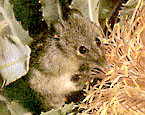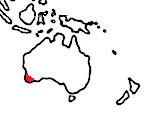|
Honey
Possum
(Tarsipes rostratus) |
|
Physical
characteristics and distribution
|
|
This
species is sexually dimorphic, with females the larger of the
two sexes. Head and body length range from 70 to 85mm. Tail
length is 88 to 100mm. A male of head and body length 78mm weighed
13 grams and a female of 81mm weighed 17 grams. The distribution of Tarsipes rostratus is restricted to the sandplain heathlands, shrublands, and open low woodlands with heath understory that patchily surround Australia's arid center. The biology of this animal is linked to the distribution and flowering patterns of nectar producing flowers, and flowering plant species-richness is directly related to numbers of Tarsipes individuals. It lives in small groups, hunting for food, feeding on pollen, nectar, and insects. It explores flowers thoroughly with its long snout in search of its prefered foods, which include pollen and nectar from Banksia, bottlebrushes, hakeas, dandras, Ti, and eucalypt. It gathers it with its 2.5cm bristled tongue, scraping it onto its upper canines and lower incisors. It is located in SW Western Australia. |
|
Description
of the brain
|
|
Animal
source and preparation
|
|
All
specimens collected followed the same preparation
and histological procedure.
|
Other Related Resources (websites and publications)
List of Specimens | Explore Collections | Brain Sections | Brain Evolution | Brain Development | Brain Circuitry | Brain Functions | Location and Use | Related Web Sites | Contact Us | Search MSU Database | Personnel | Home



